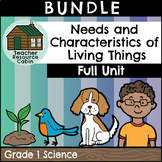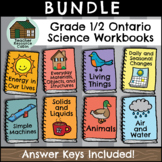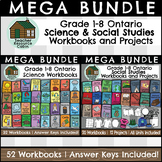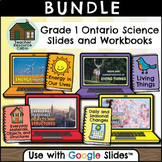Needs and Characteristics of Living Things Workbook (Grade 1 Ontario Science)
- Zip
- Easel Activity
What educators are saying
Also included in
- This full unit contains everything you need for teaching the Grade 1 Needs and Characteristics of Living Things unit in the NEW 2022 Ontario Science Curriculum! This unit includes a FULL unit plan (with suggestions for 21 daily lessons), a workbook, a slideshow, STEM experiments/investigations, a fiPrice $31.05Original Price $34.50Save $3.45
- This full unit MEGA BUNDLE contains everything you need to teach Grade 1 Science, aligned with the NEW 2022 Ontario Science Curriculum! All four Grade 1 Science units are included: Everyday Materials, Objects, and Structures, Energy in Our Lives, Daily and Seasonal Changes, and Needs and CharacterisPrice $120.00Original Price $142.00Save $22.00
- This BUNDLE includes FOUR independent workbooks for Grade 1 students, aligned with the NEW 2022 Ontario Science curriculum. Each workbook meets the Ontario Curriculum expectations for an ENTIRE Science unit.All four Grade 1 Science strands are included: Everyday Materials, Objects, and Structures, EPrice $34.00Original Price $38.00Save $4.00
- This BUNDLE contains EIGHT independent Science workbooks for Grade 1 and 2 students. Each workbook meets the Ontario Curriculum expectations for an ENTIRE Science unit. All Grade 1/2 Science strands are included!Grade 1: Everyday Materials, Objects, and Structures, Energy in Our Lives, Daily and SeaPrice $67.00Original Price $76.00Save $9.00
- This MEGA BUNDLE contains workbooks for ALL Grade 1 - 8 Ontario Science Units. Each workbook meets the NEW 2022 Ontario Science Curriculum expectations for an ENTIRE Science unit. This product is PERFECT for a prep coverage teacher that teaches science to multiple grade levels. All workbooks are no-Price $292.00Original Price $313.25Save $21.25
- This MEGA BUNDLE contains workbooks for ALL Grade 1-8 Ontario Science and Social Studies Units. Each workbook meets the Ontario Curriculum expectations for an ENTIRE Science or Social Studies unit.This product is PERFECT for a prep coverage teacher that teaches science and social studies to multiplePrice $464.40Original Price $580.50Save $116.10
- This MEGA BUNDLE contains workbooks for ALL Grade 1-8 Ontario Science, Social Studies, and Health Units. Each workbook meets the Ontario Curriculum expectations for an ENTIRE Science, Social Studies, and Health unit.This product is PERFECT for a prep coverage teacher who teaches Science, Social StudPrice $688.80Original Price $861.00Save $172.20
- This BUNDLE includes complete student workbooks and slide decks for Grade 1 students, aligned with the new 2022 Grade 1 Ontario Science curriculum. Each workbook meets the Ontario Curriculum expectations for an ENTIRE Science unit. Slide decks are accessed using Google Slides™. All four Grade 1 SciPrice $71.50Original Price $80.50Save $9.00
Description
This workbook covers the Grade 1 Needs and Characteristics of Living Things unit in the NEW 2022 Ontario Science curriculum (Life Systems).
In this workbook, students gain an understanding of the basic needs and characteristics of living things, including humans. Topics include the difference between needs and wants, comparisons of human and plant needs, and information about our planet and what we can do to help it.
Interactive, hands-on activities are explained, with follow-up worksheets included. There is a variety of readings, long and short answer questions, creative writing activities, cut-and-paste activities, and drawing prompts included to create a varied workbook suitable for many learning styles.
To support assessment practices, Ontario curriculum expectations (Strand A and B) are clearly identified on each page. A quiz is included at the end of the workbook.
Available in French: Les êtres vivants cahier (Grade 1 Ontario FRENCH Science)
⭐ Looking for slides to accompany this workbook? Needs and Characteristics of Living Things for Google Slides™
This resource includes:
- 41-page Needs and Characteristics of Living Things Workbook (B&W and Colour)
- 41-page Needs and Characteristics of Living Things ANSWER KEY
- TpT Easel Activity - This tool allows students to complete workbook pages digitally, with no printing necessary. New to using Easel by TpT? Check out this guide.
Table of Contents
- Title Page
- Table of Contents
- K-W-L Chart
- What is a Living Thing?
- What is a Living Thing?
- What is a Living Thing?
- What is a Living Thing?
- What is a Living Thing?
- What are Needs?
- What are Needs?
- Human Needs
- Human Needs
- Plant Needs
- Food
- Air
- Water
- Shelter
- What is an Environment?
- What is an Environment?
- Environment Scavenger Hunt
- What are Characteristics?
- What are Characteristics?
- Parts of a Plant
- Parts of a Plant
- Parts of a Plant
- Parts of a Plant
- Parts of an Animal
- Parts of an Animal
- Parts of an Animal
- The Human Body
- The Human Body
- The Human Body
- The Human Body
- Our Healthy Planet
- Our Healthy Planet
- Air Quality
- Water Quality
- Our Healthy Planet
- Vocabulary
- Living Things Quiz
- Living Things Quiz
Grade 1 Ontario Science Curriculum Expectations (2022)
B. Life Systems - Needs and Characteristics of Living Things
B1. assess the importance of a healthy environment for living and non-living things, and the responsibilities of humans in contributing to a healthy environment
B2. demonstrate an understanding of the basic needs and characteristics of living things, including humans
Please read our Terms of Use prior to using this resource.
©Copyright Teacher Resource Cabin
Buyer Tip:
If you have purchased this product, please leave feedback! We are always looking for ways to improve our store and your input is important. You will earn TpT Credits by leaving ratings and reviews on your purchases. For every $1 you spend on TpT, you can earn 1 credit. Every 20 credits earned equals $1 you can apply to future TpT purchases.














